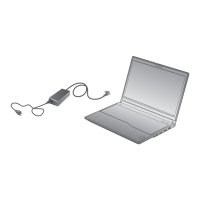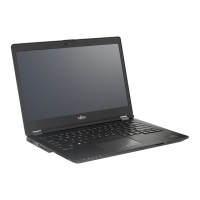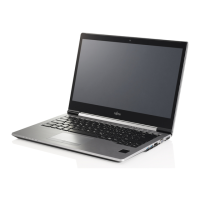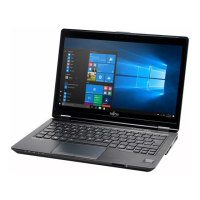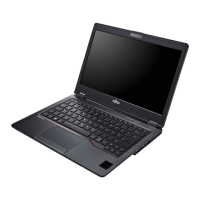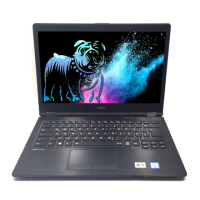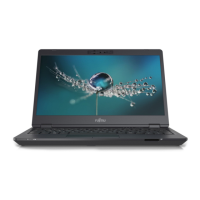Do you have a question about the Fujitsu LIFEBOOK U7511 and is the answer not in the manual?
Links to additional documentation and resources for the notebook.
Details ports and indicators on the front of the notebook.
Identifies and describes ports located on the left side of the notebook.
Identifies and describes ports located on the right side of the notebook.
Details ports and features on the bottom of the notebook.
Details ports and indicators on the front of the U7511 model.
Identifies and describes ports on the left side of the U7511 model.
Identifies and describes ports on the right side of the U7511 model.
Details ports and features on the bottom of the U7511 model.
Essential safety information and warnings for notebook operation.
Safety guidelines specific to wireless features like WLAN and Bluetooth.
Advice for using and transporting the notebook during travel.
Procedures for safely cleaning the notebook's exterior and screen.
Steps for unboxing and checking the notebook for damage.
Guidance on selecting a suitable workspace and connecting the mains adapter.
Procedures for the initial startup and software installation.
Explanation of the notebook's status lights and their meanings.
Step-by-step guide for switching the notebook on and off.
How to use the virtual numeric keypad for data entry.
Using function keys and key combinations for shortcuts and special features.
Configuration of F-Lock, keyboard lighting, and country settings.
Moving the cursor and selecting items using the touchpad.
Using touch gestures and managing display output.
Using the built-in webcam and optional privacy filter.
Guidelines for charging, caring for, and maintaining the rechargeable battery.
Utilizing power-saving options to extend battery life.
Adjusting system performance and fan settings.
Inserting, removing, and supported formats for memory cards.
Procedure for inserting and removing the SIM card.
Switching wireless LAN, Bluetooth, and LTE/5G on/off.
Connecting to networks using Ethernet LAN ports.
Details of ports on the port replicator and connecting peripherals.
Steps for connecting and disconnecting the notebook from the port replicator.
Configuring fingerprint and palm vein sensors for secure login.
Setting up and managing BIOS supervisor and user passwords.
Enabling and disabling the TPM security chip for enhanced protection.
Using the Smart Card reader for authentication and security.
How to connect and configure external display monitors.
Connecting various USB devices like printers, drives, and peripherals.
Utilizing USB-C ports for charging, display, and data transfer.
Connecting audio devices like headsets and microphones.
Steps to start, navigate, and exit the BIOS setup utility.
Using the BIOS utility to securely delete data from storage devices.
Procedures for diagnosing and resolving notebook problems.
How to restore the system from recovery media or Windows settings.
Solutions for common errors like blank screens, connectivity, and startup failures.
Technical details on ambient conditions, dimensions, memory, and battery.
Electrical data for notebook and port replicator power adapters.
Links to additional documentation and resources for the notebook.
Details ports and indicators on the front of the notebook.
Identifies and describes ports located on the left side of the notebook.
Identifies and describes ports located on the right side of the notebook.
Details ports and features on the bottom of the notebook.
Details ports and indicators on the front of the U7511 model.
Identifies and describes ports on the left side of the U7511 model.
Identifies and describes ports on the right side of the U7511 model.
Details ports and features on the bottom of the U7511 model.
Essential safety information and warnings for notebook operation.
Safety guidelines specific to wireless features like WLAN and Bluetooth.
Advice for using and transporting the notebook during travel.
Procedures for safely cleaning the notebook's exterior and screen.
Steps for unboxing and checking the notebook for damage.
Guidance on selecting a suitable workspace and connecting the mains adapter.
Procedures for the initial startup and software installation.
Explanation of the notebook's status lights and their meanings.
Step-by-step guide for switching the notebook on and off.
How to use the virtual numeric keypad for data entry.
Using function keys and key combinations for shortcuts and special features.
Configuration of F-Lock, keyboard lighting, and country settings.
Moving the cursor and selecting items using the touchpad.
Using touch gestures and managing display output.
Using the built-in webcam and optional privacy filter.
Guidelines for charging, caring for, and maintaining the rechargeable battery.
Utilizing power-saving options to extend battery life.
Adjusting system performance and fan settings.
Inserting, removing, and supported formats for memory cards.
Procedure for inserting and removing the SIM card.
Switching wireless LAN, Bluetooth, and LTE/5G on/off.
Connecting to networks using Ethernet LAN ports.
Details of ports on the port replicator and connecting peripherals.
Steps for connecting and disconnecting the notebook from the port replicator.
Configuring fingerprint and palm vein sensors for secure login.
Setting up and managing BIOS supervisor and user passwords.
Enabling and disabling the TPM security chip for enhanced protection.
Using the Smart Card reader for authentication and security.
How to connect and configure external display monitors.
Connecting various USB devices like printers, drives, and peripherals.
Utilizing USB-C ports for charging, display, and data transfer.
Connecting audio devices like headsets and microphones.
Steps to start, navigate, and exit the BIOS setup utility.
Using the BIOS utility to securely delete data from storage devices.
Procedures for diagnosing and resolving notebook problems.
How to restore the system from recovery media or Windows settings.
Solutions for common errors like blank screens, connectivity, and startup failures.
Technical details on ambient conditions, dimensions, memory, and battery.
Electrical data for notebook and port replicator power adapters.
| Graphics | Intel Iris Xe Graphics |
|---|---|
| Webcam | 720p HD |
| Processor | i7-1165G7, i5-1145G7, i5-1135G7 |
| CPU | Intel Core i5-1235U |
| RAM | 8GB or 16GB DDR4 |
| Storage | 512 GB SSD |
| Display | 15.6" FHD (1920 x 1080) |
| Operating System | Windows 10 Pro |
| Battery Life | Up to 12 hours |
| Ports | USB-C, USB 3.2, HDMI, Ethernet |
| Wireless | Wi-Fi 6, Bluetooth 5.1 |


